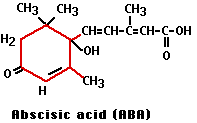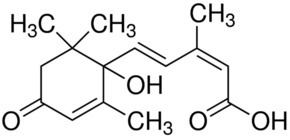3DMet B00898 Formula C15H20O4 Appearance Colorless crystals | Abbreviations ABA Boiling point 120 °C | |
 | ||
Plant hormonal control abscisic acid
Abscisic acid (ABA), also known as Dormin, Dormic acid (DMA), is best known as a plant hormone. ABA functions in many plant developmental processes, including bud dormancy. It is degraded by the enzyme (+)-abscisic acid 8'-hydroxylase into phaseic acid.
Contents
- Plant hormonal control abscisic acid
- Biology plant growth development part 13 abscisic acid cbse class 11 xi
- Function
- Biosynthesis
- Location and timing of ABA biosynthesis
- Inactivation
- Effects
- In Fungi
- In Animals
- Measurement of ABA Concentration
- References

Biology plant growth development part 13 abscisic acid cbse class 11 xi
Function

ABA was originally believed to be involved in abscission. This is now known to be the case only in a small number of plants. ABA-mediated signaling also plays an important part in plant responses to environmental stress and plant pathogens. The plant genes for ABA biosynthesis and sequence of the pathway have been elucidated. ABA is also produced by some plant pathogenic fungi via a biosynthetic route different from ABA biosynthesis in plants.

Abscisic acid owes its names to its role in the abscission of plant leaves. In preparation for winter, ABA is produced in terminal buds. This slows plant growth and directs leaf primordia to develop scales to protect the dormant buds during the cold season. ABA also inhibits the division of cells in the vascular cambium, adjusting to cold conditions in the winter by suspending primary and secondary growth.

Abscisic acid is also produced in the roots in response to decreased soil water potential and other situations in which the plant may be under stress. ABA then translocates to the leaves, where it rapidly alters the osmotic potential of stomatal guard cells, causing them to shrink and stomata to close. The ABA-induced stomatal closure reduces transpiration, thus preventing further water loss from the leaves in times of low water availability. A close linear correlation was found between the ABA content of the leaves and their conductance (stomatal resistance) on a leaf area basis.
Seed germination is inhibited by ABA in antagonism with gibberellin. ABA also prevents loss of seed dormancy.

Several ABA-mutant Arabidopsis thaliana plants have been identified and are available from the Nottingham Arabidopsis Stock Centre - both those deficient in ABA production and those with altered sensitivity to its action. Plants that are hypersensitive or insensitive to ABA show phenotypes in seed dormancy, germination, stomatal regulation, and some mutants show stunted growth and brown/yellow leaves. These mutants reflect the importance of ABA in seed germination and early embryo development.
Pyrabactin (a pyridyl containing ABA activator) is a naphthalene sulfonamide hypocotyl cell expansion inhibitor, which is an agonist of the seed ABA signaling pathway. It is the first agonist of the ABA pathway that is not structurally related to ABA.
Biosynthesis
Abscisic acid (ABA) is an isoprenoid plant hormone, which is synthesized in the plastidal 2-C-methyl-D-erythritol-4-phosphate (MEP) pathway; unlike the structurally related sesquiterpenes, which are formed from the mevalonic acid-derived precursor farnesyl diphosphate (FDP), the C15 backbone of ABA is formed after cleavage of C40 carotenoids in MEP. Zeaxanthin is the first committed ABA precursor; a series of enzyme-catalyzed epoxidations and isomerizations via violaxanthin, and final cleavage of the C40 carotenoid by a dioxygenation reaction yields the proximal ABA precursor, xanthoxin, which is then further oxidized to ABA. via abscisic aldehyde.
Abamine has been designed, synthesized, developed and then patented as the first specific ABA biosynthesis inhibitor, which makes it possible to regulate endogenous levels of ABA.
Location and timing of ABA biosynthesis
Inactivation
ABA can be catabolized to phaseic acid via CYP707A (a group of P450 enzymes) or inactivated by glucose conjugation (ABA-glucose ester) via the enzyme AOG. Catabolism via the CYP707As is very important for ABA homeostasis, and mutants in those genes generally accumulate higher levels of ABA than lines overexpressing ABA biosynthetic genes. In soil bacteria, an alternative catabolic pathway leading to dehydrovomifoliol via the enzyme vomifoliol dehydrogenase has been reported.
Effects
In Fungi
Like plants, some fungal species (for example Cercospora rosicola, Botrytis cinerea and Magnaporthe oryzae) have an endogenous biosynthesis pathway for ABA. In fungi, it seems to be the MVA biosynthetic pathway that is predominant (rather than the MEP pathway that is responsible for ABA biosynthesis in plants). One role of ABA produced by these pathogens seems to be to suppress the plant immune responses.
In Animals
ABA has also been found to be present in metazoans, from sponges up to mammals including humans. Currently, its biosynthesis and biological role in animals is poorly known. ABA has recently been shown to elicit potent anti-inflammatory and anti-diabetic effects in mouse models of diabetes/obesity, inflammatory bowel disease, atherosclerosis and influenza infection. Many biological effects in animals have been studied using ABA as a nutraceutical or pharmacognostic drug, but ABA is also generated endogenously by some cells (like macrophages) when stimulated. There are also conflicting conclusions from different studies, where some claim that ABA is essential for pro-inflammatory responses whereas other show anti-inflammatory effects. Like with many natural substances with medical properties, ABA has become popular also in naturopathy. Whlile ABA clearly has beneficial biological activities and many naturopathic remedies will contain high levels of ABA (such as wheatgrass juice, fruits and vegetables), some of the health claims made may be exaggerated or overly optimistic. Its anti-cancer properties are, for example, poorly supported at this moment but not completely dismissed. (and A1 US application US20060292215 A1, Gonzalo Romero M, "Abscisic acid against cancer", published 2006-12-28 ). In mammalian cells ABA targets a protein known as lanthionine synthetase C-like 2 (LANCL2), triggering an alternative mechanism of activation of peroxisome proliferator-activated receptor gamma ((PPAR gamma)). Interestingly, LANCL2 is conserved in plants and was originally suggested to be an ABA receptor also in plants, which was later challenged.
An aquatic herbicide, fluridone, has been found to act as an anti-inflammatory drug in humans. Fluridone inhibits photosynthesis by disruption of ABA, killing plants systemically. This same inhibition of ABA in humans leads to an anti-inflammatory response.
Oral ABA at 0.5–1 µg/kg significantly lowered hyperglycemia and insulinemia in rats and in humans. So, low-dose ABA intake may be proposed as an aid to improving glucose tolerance in patients with diabetes who are deficient in or resistant to insulin.
Measurement of ABA Concentration
Several methods can help to quantify the concentration of abscisic acid in a variety of plant tissue. The quantitative methods used are based on HPLC and GC, and ELISA. Recently, 2 independent FRET probes have been developed that can measure intracellular ABA concentrations in real time in vivo.
